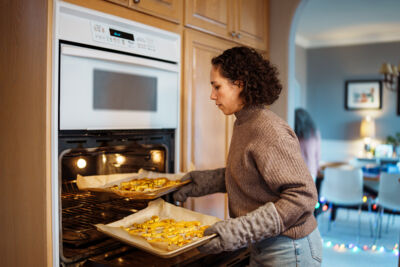Fire Safety at Home

We all want our homes to be a place of comfort and safety. To protect yourself and your loved ones, it’s important to know how to prevent fires in the home and be prepared in the event of an emergency.
Below are some home fire safety and prevention tips to share with your household.
Learn How to Prevent and Prepare for Cooking Fires
Cooking is the leading cause of fires in the home, according to the National Fire Protection Association.
As you prepare to spend more time at home during the cold months ahead and look forward to gathering with your loved ones for winter holidays, here are some tips to increase kitchen safety and help ensure that your home cooking sparks joy – not a fire.
- Never leave food on the stove unattended.
- Keep flammable items like kitchen towels, potholders and recipe books away from the stove.
- If you are baking or roasting food, check your oven regularly and use a timer as a reminder.
In the event of a cooking fire remember: When in doubt, just get out! Close the door behind you to help contain the fire and call 9-1-1 from outside your home. If you attempt to put a small fire out yourself, make sure others in your household are getting out and that you have a clear way out yourself.
Putting out a small grease fire:
Never use water on a grease fire.
- Turn off the heat.
- Slide a lid or baking sheet over the pan to smother the fire.
Do not attempt to take the burning pan outside.
For a small oven fire:
- Turn off the heat.
- Keep the oven door closed. Remember, air fuels fire.
For more cooking safety tips, visit the National Fire Protection Association website.
Make Sure Smoke Alarms Are Installed and Working
Working smoke alarms are essential for home fire safety. The best way to keep you and your family safe is to have working smoke detectors on every level of your home and in your bedrooms.
According to research by the NFPA, 59% of home fire deaths between 2018 and 2022 were caused by fires in properties with no smoke alarms or smoke alarms that failed to operate.
To make sure your household is protected:
- Install a sufficient number of smoke alarms for your home. There should be a smoke alarm on every level of your home, outside each sleeping area and inside each bedroom.
- Test your smoke alarms every month using the test feature on the detector.
- Replace the batteries in the detector at least once a year.
- Replace your smoke detector every 10 years.
Have a Plan and Practice
What are the options to escape if the main door is blocked? Where will you all meet once out of the home? A fire drill goal should be to get everyone out of the house in two minutes or less.
If you need help creating a plan, visit Ready.gov for tips and informational videos. Once you have your fire escape plan in place, here are tips to keep it fresh in your memory:
- Discuss your fire evacuation plan with your household and make sure that every family member knows two ways to escape from every room of the home.
- If your home has a second floor, purchase a hanging ladder and make sure all family members know how to use it.
- Practice regular fire drills. Even the best plan won’t work if your household doesn’t remember how to execute it! Practice evacuating your home and meeting at your designated spot in two minutes or less.
Additional Reading and Resources
- 7 Ways to Prepare for a Home Fire, American Red Cross
- Safety Tip Sheets, NFPA
- Home Fire Safety Information organized by topic, NFPA
- Preparing Homes for Wildfire, NFPA
![Alaska Housing Finance Corporation [Logo]](/application/themes/ahf2/images/logo.png?v=2)